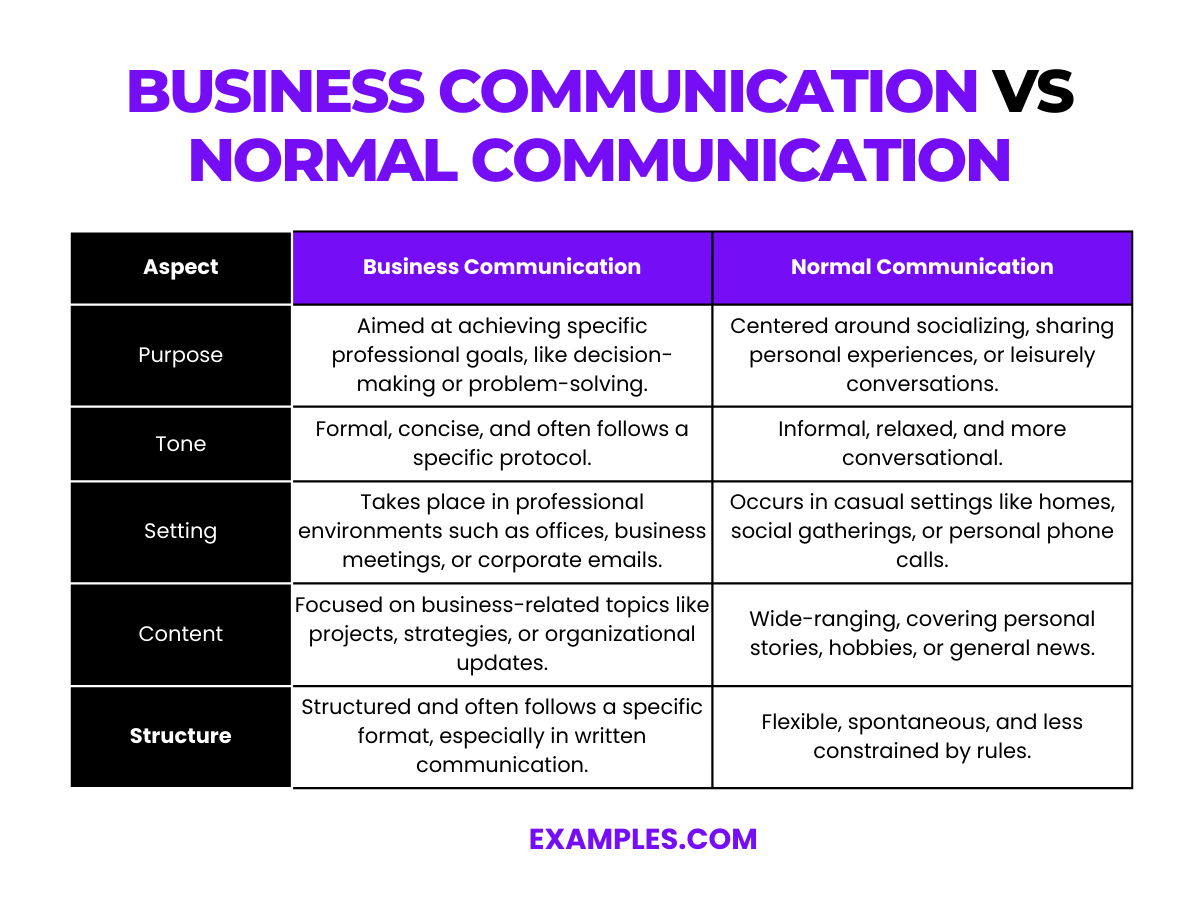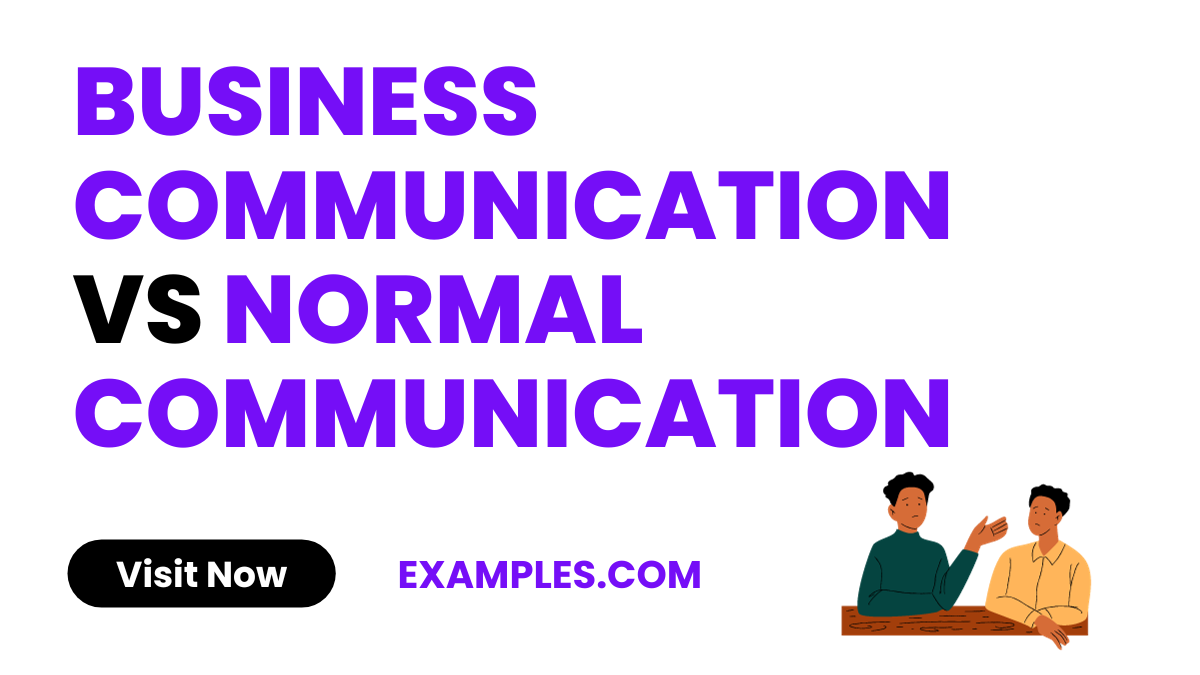Business Communication vs Normal Communication: Difference Between, Examples, PDF
Navigating the nuances between business communication and normal communication is essential for professional and personal growth. This comprehensive guide, enriched with practical communication examples, delves into the fundamental differences and similarities between these two communication styles. Business communication, structured and goal-driven, is pivotal in professional settings, focusing on clarity and efficiency. In contrast, normal communication is more relaxed and personal, often characterized by informal dialogues and emotional exchanges. By understanding these distinctions, readers can enhance their communication skills in various contexts, leading to more effective and meaningful interactions.
Download Business Communication PDF
Download Normal Communication PDF
Difference Between Business Communication and Normal Communication
 In today’s diverse communicative landscape, it’s crucial to distinguish between business communication and normal communication. This guide offers a structured comparison, presented in a table format, to elucidate the key differences and similarities between these two forms of communication. Understanding these distinctions is essential for effective interaction in both professional and personal settings.
In today’s diverse communicative landscape, it’s crucial to distinguish between business communication and normal communication. This guide offers a structured comparison, presented in a table format, to elucidate the key differences and similarities between these two forms of communication. Understanding these distinctions is essential for effective interaction in both professional and personal settings.
| Aspect | Business Communication | Normal Communication |
|---|---|---|
| Purpose | Aimed at achieving specific professional goals, like decision-making or problem-solving. | Centered around socializing, sharing personal experiences, or leisurely conversations. |
| Tone | Formal, concise, and often follows a specific protocol. | Informal, relaxed, and more conversational. |
| Setting | Takes place in professional environments such as offices, business meetings, or corporate emails. | Occurs in casual settings like homes, social gatherings, or personal phone calls. |
| Content | Focused on business-related topics like projects, strategies, or organizational updates. | Wide-ranging, covering personal stories, hobbies, or general news. |
| Structure | Structured and often follows a specific format, especially in written communication. | Flexible, spontaneous, and less constrained by rules. |
| Feedback | Direct and immediate, aimed at clarity and furthering business objectives. | More personal and empathetic, focused on building relationships. |
| Non-Verbal Cues | Professional body language, limited use of gestures, maintaining a formal demeanor. | Rich in expressions, gestures, and a wider range of body language. |
| Technology | Utilizes formal communication tools like business software, professional email platforms, and virtual meeting rooms. | Leverages informal channels such as social media, personal emails, or messaging apps. |
This table provides a clear overview of the distinctive features of business and normal communication. By understanding these differences, individuals can tailor their communication style to suit the context, ensuring effective and appropriate interactions in various scenarios.
10 Business Communication Examples
Business communication is integral to the professional world, encompassing various formats and styles to meet different organizational needs. This type of communication is characterized by its formal tone, clear structure, and focus on efficiency and clarity. Here, we will explore ten distinct and effective business communication examples, each with a unique role in facilitating business operations and enhancing workplace dynamics.
- Formal Business Meetings: Organized to discuss key company strategies, make decisions, or address organizational issues. Essential for collaborative decision-making and maintaining alignment among team members.
- Professional Emails: A primary mode of communication in business, used for official correspondence, sharing information, and maintaining records.
- Business Reports: Detailed documents presenting analysis, research findings, or progress updates. Crucial for informed decision-making and strategic planning.
- Presentations: Used to pitch ideas, present data, or report to stakeholders. Combine verbal communication with visual aids for effective information delivery.
- Corporate Memos: Brief written documents to inform employees about policies, changes, or announcements. They ensure everyone in the organization is on the same page.
- Business Letters: Formal letters to external stakeholders, like clients or partners, for proposals, acknowledgments, or official requests.
- Project Plans: Detailed outlines of proposed projects, including objectives, timelines, and resources needed. Key for project management and clarity.
- Employee Feedback and Appraisals: Communication regarding performance reviews, feedback, and career development. Vital for employee growth and organizational development.
- Networking at Professional Events: Interactions at industry events for building connections, exchanging information, and exploring business opportunities.
- Customer Service Communication: Interactions with customers to address inquiries, solve problems, or provide assistance. Critical for customer satisfaction and loyalty.
10 Normal Communication Examples
Normal communication, also known as everyday communication, is the cornerstone of personal interactions and relationships. It’s characterized by its informal nature, flexibility, and personal touch, playing a crucial role in social bonding and personal expression. Here are ten examples of normal communication, each significant in fostering and maintaining personal connections:
- Casual Conversations: Informal chats with friends or family about daily life, interests, or experiences.
- Social Media Interactions: Engaging with friends and followers on platforms like Facebook or Instagram, sharing updates, and commenting.
- Personal Text Messages: Sending informal messages to friends or family for quick updates, plans, or just to stay in touch.
- Family Dinners: Conversations during family meals, where members catch up, share stories, or discuss day-to-day matters.
- Phone Calls with Friends: Casual calls to discuss life events, seek advice, or simply to chat.
- Community Meetings: Local gatherings for discussing neighborhood issues or planning community events.
- Book Club Discussions: Groups gathering to discuss a book, sharing personal interpretations and thoughts.
- Parent-Teacher Meetings: Informal discussions about a child’s progress or concerns in school.
- Coffee Shop Chats: Catching up with a friend over coffee, discussing a variety of personal topics.
- Online Gaming Communication: Talking with fellow gamers during online play, often about the game or other shared interests.
Comparison Between Business Communication and Normal Communication
In the realm of communication, distinguishing between business and normal (or everyday) communication is vital for effective interactions in respective contexts. This guide compares these two communication types, each serving unique purposes and adhering to different norms and styles.
Purpose and Objectives:
-
- Business communication is primarily goal-oriented, focusing on professional tasks, decisions, and formal transactions.
- Normal communication revolves around personal connections, sharing experiences, and socializing.
- Tone and Formality:
- Business communication often employs a formal tone, adhering to professional standards and etiquette.
- Normal communication is more casual, using a relaxed and conversational tone.
- Context and Setting:
- Business communication occurs in professional environments like offices, meetings, and formal emails.
- Normal communication takes place in informal settings, such as homes, social events, or casual encounters.
- Content and Structure:
- In business communication, content is usually structured, concise, and focused on specific topics relevant to work or industry.
- Normal communication is more flexible, covering a wide range of personal and general interest topics without a rigid structure.
- Mediums and Channels:
- Professional platforms like business emails, reports, and conferences are common in business communication.
- Normal communication utilizes personal mediums like social media, phone calls, and face-to-face interactions.
- Non-Verbal Communication:
- Business communication may include controlled non-verbal cues like professional attire and formal gestures.
- In normal communication, non-verbal elements like facial expressions and body language are more expressive and varied.
Understanding these differences allows individuals to navigate both business and personal worlds more effectively, enhancing communication skills in diverse scena
Relationship Between Business Communication and Normal Communication
The relationship between business and normal communication is nuanced and interconnected. This guide explores how these two forms of communication intersect and influence each other, offering insights into their synergistic dynamics.
Intersecting Dynamics
- Skill Transferability:
- Skills honed in business communication, such as clarity and conciseness, can greatly enhance the effectiveness of normal communication.
- Similarly, the empathy and adaptability often practiced in normal communication can improve interpersonal skills in a business context.
- Influence on Personal Branding:
- The professionalism and efficiency characteristic of business communication can positively impact one’s personal brand in normal social interactions.
- Conversely, the authenticity and emotional intelligence from normal communication can enrich one’s professional persona.
- Adaptation in Different Contexts:
- Understanding the nuances of both types helps in adapting communication strategies according to the situation, whether in a boardroom or at a social gathering.
- This adaptability is crucial in today’s world where professional and personal lives often overlap, especially in digital communication.
- Cultural and Contextual Sensitivity:
- Both forms of communication require an awareness of cultural and contextual factors, ensuring appropriate and effective interaction in diverse settings.
- Technological Influence:
- Advances in technology have blurred the lines between these two types, with platforms like LinkedIn and corporate chat apps fostering a blend of professional and casual communication styles.
Understanding and leveraging the relationship between business and normal communication can lead to more nuanced and effective interactions in both personal and professional spheres.
In conclusion, the article “Business Communication vs Normal Communication” from Examples.com provides an in-depth comparison of these two communication types. It focuses on the differences in purpose, tone, setting, content, structure, feedback, non-verbal cues, and technology use between business and normal communication. The article also includes examples of both types, highlighting how they are applied in various scenarios.
To enhance the content, consider incorporating external resources for additional insights: For a deeper understanding of how business communication has evolved in remote working scenarios, you might find valuable information on The African American Board Leadership Institute. To explore the educational aspects of communication, OER Texas offers comprehensive learning materials that could enrich your understanding of these communication forms.


